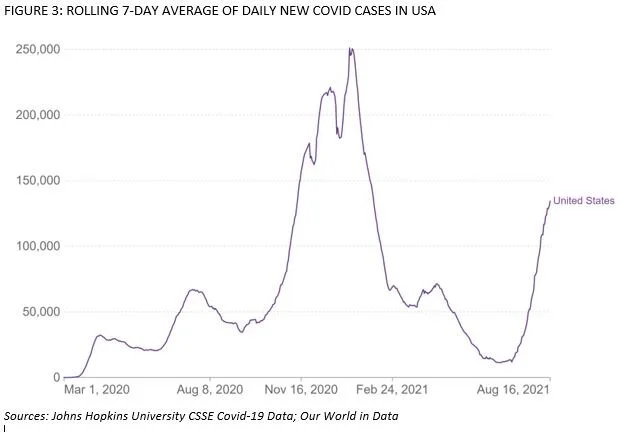THE COVID-19 DELTA WAVE: THE U.K. IS NOT INDIA 2.0
In the past few weeks, we have often heard from the media and experts that the emergence and then dominance of the delta mutation of Covid-19 is a painful though short-lived phenomenon. That assumption was based on the statistics from India, where the delta variant is thought to have originated.
India saw a surge in the daily Covid-19 case load beginning in March 2021, peaking in mid-May at almost 400,000 cases, and rapidly dropping off thereafter. By the end of June, the number of new daily infections on a rolling 7-day average in India had fallen dramatically to under 50,000 cases and have more gradually decreased down to 36,874 as of August 14, 2021. The underlying basis for this rapid surge followed by equally fast decline was presumably because Covid-19 delta is 2x more contagious than the original virus type, and that the “delta” simply ran out of people to infect. In other words, its more contagious nature is precisely the reason why delta comes and goes in an accelerated fashion.
At first, the emergence of the delta mutation in the U.K. seemed to follow a similar path: a sharp rise that began in early June, peaking in mid-July (i.e, about 5 weeks later), and beginning a rapid decent thereafter. In the U.S., our “third wave” began in early July, about 4 weeks after the UK. Dr. Scott Gottlieb, arguably the best source of information on this pandemic, tried to provide some assurances when he stated on CNBC a few weeks ago that the third wave in the U.S. was 3-4 weeks behind the U.K., and that the delta wave should thus peak out by mid-August. In sum, the experience in India with Covid-19 delta was extrapolated to what would happen in the UK, and further extrapolated to what would happen here.
This hopeful line of reasoning appears to have been challenged by the most recent epidemiological data from the U.K. The daily case number did indeed consistently decline after mid-July – though at a lower rate than in India – and so the reassuring words from our experts seemed to be borne out by the statistics. Even Wall Street noticed. Some strategists recommended rotating back into the recovery stocks based on what appeared to be a rapid decline in Covid cases in the U.K.
Unfortunately, the cases in the U.K. began to flatten out in late July and have actually inched back up. U.K.’s third wave began in early June at 3000+ cases, peaked in mid-July at approximately 48,000 cases, then proceeded to settle out around 25,000 cases. Since then, the case load has slowly increased and is now hovering at a 7-day moving average of 28,000. Clearly, the third wave in the UK is taking on some very different characteristics than the one in India. The reasons for this surprising and disappointing pattern are unclear but certainly multifactorial.
And so, we find ourselves wondering which country model the U.S. will follow -that of India or the U.K. At this point, the daily caseload in the US is still on upward trajectory, though the rate of increase has slowed somewhat. On a rolling 7-day average basis, the daily new Covid-19 case count on August 16 2021 is 132,707. Over the past weekend, NIH director Dr. Francis Collins stated that he would be surprised were the U.S. not exceed a daily new infection rate of 200,000 sometime in mid or late September. Predicting what happens after the peak - and how fast it happens - is challenging because of the different paths that the virus statistics have taken in India and the UK.



